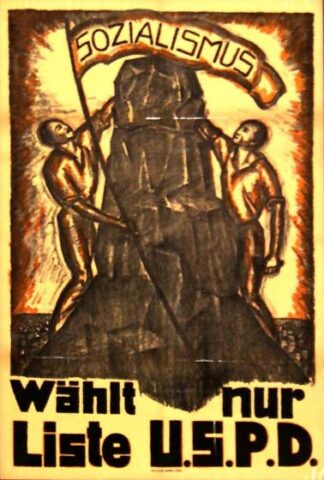
Divisions over ideology and policy in the ranks of the SPD gave birth to two Weimar left-wing parties: the Independent Social Democratic Party of Germany (Unabhängige Sozialdemokratische Partei Deutschland, or USPD) and the Communist Party of Germany (Kommunistische Partei Deutschlands, or KPD). Both emerged in 1917, in response to the SPD’s support for the war effort. The USPD was comparatively shorted lived, lasting until 1922, but the fracture between the SPD and KPD would continue until the last days of the Weimar Republic.
The USPD’s founder and first leader was Hugo Haase, a Jewish lawyer who had served as SPD chairman prior to the war. In April 1917, Haase and several like-minded colleagues broke away from the SPD to begin their own anti-war campaign. They organised mass strikes, chiefly as a means of protesting against food shortages and the commandeering of civilian necessities by the military. The USDP’s strong stance against the war, the imperial government and the mainstream SPD won it many supporters. The USPD position was that the leaders of the SPD had ‘sold out’ the party’s socialist values by making concessions to the Kaiser and his government.
The end of the war brought about a temporary easing of hostilities between the USPD and SPD. The two groups agreed to work together on the preparations for a future national assembly; their leaders, Haase and Friedrich Ebert, both sat on a ‘council of people’s deputies’. But six weeks later the USPD again split from the SPD, this time over the latter’s inaction over Reichswehr and Freikorps street violence. The USPD decided to go it alone as a parliamentary party. It fielded candidates in the first two Weimar federal elections, winning 22 seats in January 1919 and 84 seats in June 1920; the latter result made it the second largest party in the Reichstag after the SPD. The murder of Haase triggered internal divisions within the USPD, which allowed the KPD to overtake it as Germany’s largest left-wing party. USPD membership dwindled and in 1922, most of the party was absorbed back into the SPD.
The KPD was formed by the Spartacist League in late December 1918. The KPD platform initially called for a socialist revolution along Bolshevik lines: class consciousness, the organisation of the working classes, armed revolution and a ‘dictatorship of the proletariat’. But the failed January 1919 uprising in Berlin, along with the deaths of Rosa Luxemburg, Karl Liebknecht and several other leaders, forced the KPD to reinvent itself as a functioning parliamentary party. The KPD fielded candidates in the 1920 election but won just two per cent of the vote and four Reichstag seats.
The KPD’s fortunes changed in late 1920, for two reasons. Firstly, it came under the direction of the Communist International (or Comintern) in Moscow, which provided tactical and organisational advice. Secondly, a split in the USPD sent around 300,000 members of its left wing to join the KPD. This boosted the KPD’s potential share of the vote to as high as 10 per cent. In December 1924 the KPD won 62 Reichstag seats, mostly at the expense of the SPD. The Great Depression and its impact on Germany saw the KPD’s electoral fortunes improve further, mirroring the rise of the NSDAP. In September 1930 the communists returned 77 Reichstag seats. In the two elections held in 1932, this increased to 89 seats (July) and then 100 seats (November). Like the Nazis, the KPD was an obstructionist party with no commitment to the republic and no willingness to support the government. The party’s rhetoric and propaganda campaign against the Weimar constitution, democracy and capitalism helped to lower public morale and drive voters away from the mainstream parties.

1. Ideological divisions, particularly over support for the war, saw two groups break away from the SPD in 1917.
2. The USPD was the more moderate, taking a strong anti-war stand but supporting the Weimar Republic.
3. The more radical and revolutionary KPD was formed from the ruins of the Spartacists after their failed revolt in 1919.
4. By 1922 the USPD had split and around 300,000 of its members crossed to the KPD, which boosted its prospects.
5. The Great Depression saw voter support for the KPD rise significantly, alongside that of the Nazi Party.
© Alpha History 2014. Content on this page may not be republished or distributed without permission. For more information please refer to our Terms of Use.
This page was written by Jennifer Llewellyn, Jim Southey and Steve Thompson. To reference this page, use the following citation:
J. Llewellyn et al, “Weimar communist parties (KPD and USPD)”, Alpha History, 2014, accessed [today’s date], http://alphahistory.com/weimarrepublic/weimar-left-wing-parties/.
